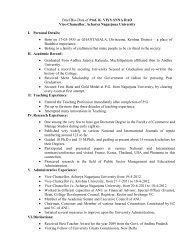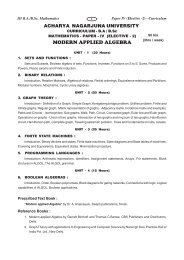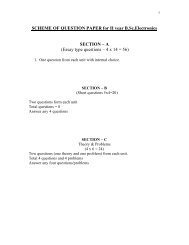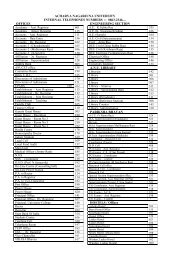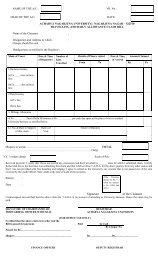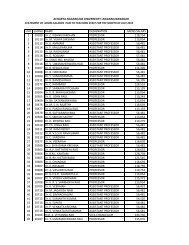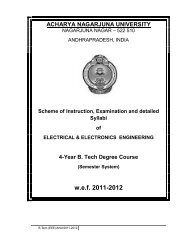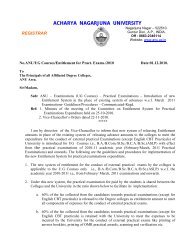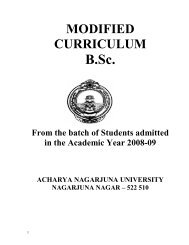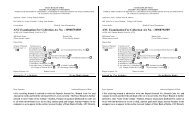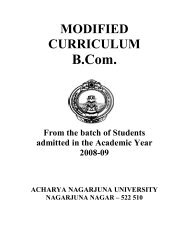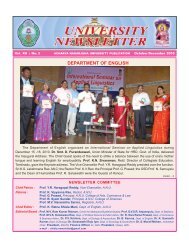paper - iv - Acharya Nagarjuna University
paper - iv - Acharya Nagarjuna University
paper - iv - Acharya Nagarjuna University
You also want an ePaper? Increase the reach of your titles
YUMPU automatically turns print PDFs into web optimized ePapers that Google loves.
III B.A./B.Sc. Mathematics<br />
1<br />
ACHARYA NAGARJUNA UNIVERSITY<br />
CURRICULUM - B.A / B.Sc<br />
MATHEMATICS - PAPER - IV (ELECTIVE - 1)<br />
NUMERICAL ANALYSIS<br />
(Syllabus for the academic years 2010-2011 and onwards)<br />
Paper IV (Elect<strong>iv</strong>e -1) - Curriculum<br />
90 Hours<br />
UNIT - I<br />
20 Hours<br />
Errors in Numerical computations : Numbers and their Accuracy, Errors and their<br />
Computation, Absolute, Relat<strong>iv</strong>e and percentage errors, A general error formula, Error in a series<br />
approximation.<br />
Solution of Algebraic and Transcendental Equations : The bisection method, The iteration<br />
method, The method of false position, Newton- Raphson method, Generalized Newton-Raphson<br />
method, Ramanujan's method, Muller's method.<br />
UNIT - II<br />
25 Hours<br />
Interpolation : Errors in polynomial interpolation, Forward differences, Backward differences,<br />
Central Differences, Symbolic relations, Detection of errors by use of D. Tables, Differences of a<br />
polynomial, Newton's formulae for interpolation formulae, Gauss's central difference formula, Stirling's<br />
central difference formula, Interpolation with unevenly spaced points, Lagrange's formula, Error in<br />
Lagrange's formula, Der<strong>iv</strong>ation of governing equations, End conditions, D<strong>iv</strong>ided differences and their<br />
properties, Newton's general interpolation.<br />
UNIT - III<br />
20 Hours<br />
Curve Fitting : Least-Squares curve fitting procedures, fitting a straight line, nonlinear curve<br />
fitting, Curve fitting by a sum of exponentials.<br />
Numerical Differentiation and Numerical Integration : Numerical differentiation, Errors in<br />
numerical differentiation, Maximum and minimum values of a tabulated function, Numerical integration,<br />
Trapezoidal rule, Simpson's 1/3-rule, Simpson's 3/8 - rule, Boole's and Weddle's rule.<br />
UNIT - IV<br />
25 Hours<br />
Linear systems of equations : Solution of linear systems - Direct methods, Matrix inversion<br />
method, Gaussian elimination method, Method of factorization, Ill-conditioned linear systems. Iterat<strong>iv</strong>e<br />
methods : Jacobi's method, Gauss-siedal method.<br />
Numerical solution of ordinary differential equations : Introduction, Solution by Taylor's<br />
Series, Picard's method of Success<strong>iv</strong>e approximations, Euler's method, Modified Euler's method,<br />
Runge - Kutta methods, Predictor - Corrector methods, Milne's method.<br />
Prescribed Text Book :- Scope as in Introductory methods of Numerical Analysis by S.S. Sastry,<br />
Prentice Hall India (4th edition), Chapter - 1 (1.2, 1.4, 1.5, 1.6); Chapter - 2 (2.2 - 2.7); Chapter - 3 (3.2,<br />
3.3, 3.7.2, 3.9.1, 3.9.2, 3.10.1, 3.10.2); Chapter - 4 (4.2); Chapter - 5 (5.2 - 5.4.5); Chapter - 6 (6.3.2,<br />
6.3.4, 6.3.7, 6.4); Chapter - 7 (7.2 - 7.5, 7.6.2)<br />
Reference Books :-<br />
1. G. Sankar Rao New Age International Publishers, New - Hyderabad.<br />
2. Finite Differences and Numerical Analysis by H.C. Saxena, S. Chand and Company, New<br />
Delhi.
III B.A./B.Sc. Mathematics<br />
ACHARYA NAGARJUNA UNIVERSITY<br />
CURRICULUM - B.A / B.Sc<br />
MATHEMATICS - PAPER - IV (ELECTIVE - 1)<br />
NUMERICAL ANALYSIS<br />
QUESTION BANK FOR PRACTICALS<br />
UNIT - I<br />
Paper IV (Elect<strong>iv</strong>e -1) - Curriculum<br />
1. i) Which of the following numbers has the greatest precision. a) 4⋅ 3201 b) 432 ⋅ c) 4⋅320106<br />
ii) How many digits are to be taken in computing 20 so that the error does not exceed 0⋅ 01% .<br />
2. i) Sum the numbers 0⋅1532, 15⋅45, 0⋅000354, 305⋅1, 8⋅12, 143⋅3, 0⋅0212, 0⋅643<br />
and 0⋅1734where<br />
in each of which all the g<strong>iv</strong>en digits are correct.<br />
ii) If u= 5xy 2 / z<br />
3<br />
then find relat<strong>iv</strong>e maximum error in u , g<strong>iv</strong>en that ∆x = ∆y = ∆z<br />
= 0001and ⋅<br />
x = y = z =1.<br />
3<br />
3. Find a real root of the equation f ( x) = x −x− 1=<br />
0 by bisection method.<br />
3<br />
4. Find a real root of the equation x −6x− 4= 0 by bisection method.<br />
5. Find a posit<strong>iv</strong>e root of the equation xe x = 1, which lies between 0 and 1 by bisection method.<br />
6. Find the root of tan x+ x =0 upto two decimal places, which lies between 2 and 21 ⋅ by bisection<br />
method.<br />
7. Find a real root of the equation xlog 10<br />
x = 12 ⋅ by bisection method.<br />
3<br />
8. Find a real root of the equation f ( x) = x −2x− 5=<br />
0by the method of false position upto three places<br />
of decimals.<br />
3 2<br />
9. Find a real root of the equation x −x<br />
− 2= 0 by Regula-Falsi method.<br />
10. Find the root of the equation xe x = cos x using the Regula Falsi method correct to three decimal places.<br />
3<br />
11. Find the root of x + x− 1= 0by iteration method, g<strong>iv</strong>e that root lies near 1.<br />
12. Find a real root of the equation cos x = 3x−1 correct to three decimal places, using iteration method.<br />
13. Find by the iteration method, the root near 38 ⋅ , of the equation 2x− log<br />
10<br />
x = 7 correct to four decimal<br />
places.<br />
2<br />
14. Find the real root of the equation x − 5x+ 2= 0by Newton-Raphson’s method.<br />
15. Find by Newton’s method, the root of the equation e x = 4xwhich is near to 2 correct to three places of<br />
decimals.<br />
16. Using Newton-Raphson method, establish the iterat<strong>iv</strong>e formula x = 1 ⎛ N<br />
n+ x + ⎞<br />
1<br />
⎜<br />
n<br />
⎟ to calculate the square<br />
2 ⎝ x ⎠<br />
root of N. Hence find the square root of 8.<br />
2<br />
n
III B.A./B.Sc. Mathematics<br />
3<br />
Paper IV (Elect<strong>iv</strong>e -1) - Curriculum<br />
17. Using Newton-Raphson method, establish the iterat<strong>iv</strong>e formula x = 1 ⎛ N<br />
n+ x + ⎞<br />
1<br />
⎜<br />
n 2<br />
⎟<br />
3 ⎝<br />
2 to calculate the<br />
x ⎠<br />
cube root of N. Hence find the cube root of 12 applying the Newton-Raphson formula twice.<br />
18.<br />
3 2<br />
Find a double root of the equation f ( x) = x −x − x+ 1=<br />
0by generalized Newton’s method.<br />
19. Find a root of the equation xe x = 1 by Ramanujan’s method.<br />
20.<br />
3<br />
Find the root of the equation yx ( ) = x −2x− 5=<br />
0, which lies between 2 and 3 by Muller’s method.<br />
21. Show that i) ( 1+ ∆ )( 1−∇ ) = 1 ii) E∇=∆ iii)<br />
−12 / −12<br />
/<br />
δ = E ∆ = ∆ E <strong>iv</strong>)<br />
2<br />
∇ − ∆ = ∆∇ = δ<br />
v) µ = 1+<br />
1 δ<br />
4<br />
2 2<br />
n<br />
22. Evaluate i) ∆2 x<br />
3<br />
3<br />
Ex<br />
ii)<br />
⎛ ∆ 2 ⎞<br />
3<br />
⎜ ⎟<br />
⎝ E ⎠<br />
x , the interval of differencing being unity.<br />
2 3<br />
2 3<br />
23. Prove that i) u = u + ∆u + ∆ u + ∆ u ii) u = u + ∆u + ∆ u + ∆u<br />
3 2 1<br />
24. Find the missing term in the following data.<br />
x : 0 1 2 3 4<br />
y: 1 3 9 81<br />
0<br />
0<br />
4 3 2<br />
3<br />
25. Form a table of differences for the function f ( x) = x + 5x−7for x =−1012345 , , , , , , and continue<br />
the table to obtain f ( 6)<br />
and f ( 7 ).<br />
3 2<br />
26. Find the function whose first difference is x + 3x + 5x+ 12, if 1 be the interval of differencing.<br />
27. The population of a country in the decennial census were as under. Estimate the population for the year<br />
1895.<br />
Year ( x ): 1891 1901 1911 1921 1931<br />
Population ( y )(in thousands) : 46 66 81 93 101<br />
28. From the following find y value at x = 026. ⋅<br />
x 010 ⋅ 015 ⋅ 020 ⋅ 025 ⋅ 030 ⋅<br />
y = Tanx 0⋅1003<br />
0⋅1511<br />
02027 ⋅ 0⋅2553<br />
0⋅3093<br />
29. From the following table, find the number of students who obtain less than 56 marks.<br />
Marks : 30-40 40-50 50-60 60-70 70-80<br />
No. of students : 31 42 51 35 31<br />
30. Find the cubic polynomial which takes the following values.<br />
x : 0 1 2 3<br />
f ( x): 0 2 1 10<br />
1<br />
1
III B.A./B.Sc. Mathematics<br />
4<br />
Paper IV (Elect<strong>iv</strong>e -1) - Curriculum<br />
31. If l x<br />
represents the number of persons l<strong>iv</strong>ing at age x in a life table, find as accurately as the data will<br />
permit the value of l 47<br />
. G<strong>iv</strong>en that l = 512, l = 439, l = 346, l = 243 .<br />
20 30 40 50<br />
32. Apply Gauss forward formula to find the value of u 9<br />
if u = 14; u = 24; u = 32; u = 40 .<br />
0 4 8 16<br />
33. G<strong>iv</strong>en that 12500 = 111⋅ 803399; 12510 = 111⋅ 848111; 12520 = 111⋅892806;<br />
12530 = 111⋅ 937483. Show by Gauss backward formula that 12516 = 111⋅ 874930 .<br />
34. Use Stirling’s formula to find y 28<br />
, g<strong>iv</strong>en y = 49225, y = 48316, y = 47236, y = 45926,<br />
y 40<br />
= 44306 .<br />
20 25 30 35<br />
35. G<strong>iv</strong>en y = 24, y = 32, y = 35, y = 40,find y 25<br />
by Bessel’s formula.<br />
20 24 28 32<br />
36. By means of Newton’s d<strong>iv</strong>ided difference formula, find the value f () 8 and f ( 15)<br />
from the following<br />
table :<br />
x : 4 5 7 10 11 13<br />
f ( x): 48 100 294 900 1210 2028<br />
37. Using the Newton’s d<strong>iv</strong>ided difference formula, find a polynomial function satisfying the following data.<br />
x : − 4 −1 0 2 5<br />
f ( x): 1245 33 5 9 1335<br />
38. Using Lagranges interpolation formula find y at x = 301.<br />
x : 300 304 305 307<br />
y: 2⋅4771<br />
24829 ⋅ 24843 ⋅ 24871 ⋅<br />
39. By Lagrange’s interpolation formula, find the form of the function g<strong>iv</strong>en by<br />
x : 0 1 2 3 4<br />
f ( x): 3 6 11 18 27<br />
1 1 ⎡1<br />
1 ⎤<br />
40. Using Lagrange’s formula, prove that y0 = ( y1+ y− 1) − y3 − y1 − y<br />
1−<br />
y<br />
3<br />
2 8 ⎣<br />
⎢ ( ) (<br />
− −<br />
)<br />
2 2 ⎦<br />
⎥ .<br />
41. Find the least square line for the data points ( −110 , ),( 0, 9),( 17 , ),( 2, 5),( 3, 4),( 4, 3),( 5, 0 ) and ( 6, − 1)<br />
.<br />
42. Find the least square power function of the form y = ax b for the data.<br />
xi<br />
1 2 3 4<br />
yi<br />
3 12 21 35<br />
43. Fit a second degree parabola to the following data :<br />
x : 0 1 2 3 4<br />
y: 1 18 ⋅ 13 ⋅ 25 ⋅ 63 ⋅
III B.A./B.Sc. Mathematics<br />
5<br />
Paper IV (Elect<strong>iv</strong>e -1) - Curriculum<br />
44. Using the g<strong>iv</strong>en table, find dy<br />
dx and d 2<br />
y<br />
2<br />
dx<br />
at x = 12. ⋅<br />
x 10 ⋅ 12 ⋅ 14 ⋅ 16 ⋅ 18 ⋅ 20 ⋅ 22 ⋅<br />
y 27183 ⋅ 3⋅3201<br />
40552 ⋅ 49530 ⋅ 60496 ⋅ 7⋅3891<br />
90250 ⋅<br />
45. From the following table, find the values of dy<br />
dx and d 2<br />
y<br />
2<br />
dx<br />
at x = 203 ⋅<br />
x 196 ⋅ 198 ⋅ 200 ⋅ 202 ⋅ 2⋅04<br />
y 0⋅7825<br />
07739 ⋅ 0⋅7651<br />
0⋅7563<br />
07473 ⋅<br />
46. Find f ′( 06and ⋅ ) f ′′( 06from ⋅ ) the following table :<br />
x 04 ⋅ 05 ⋅ 06 ⋅ 07 ⋅ 08 ⋅<br />
f ( x) 1⋅5836<br />
1⋅7974<br />
20442 ⋅ 23275 ⋅ 26510 ⋅<br />
47. Find f ′( 25from ⋅ ) the following table :<br />
x 15 ⋅ 19 ⋅ 25 ⋅ 32 ⋅ 43 ⋅ 59 ⋅<br />
f ( x) 3375 ⋅ 6059 ⋅ 13⋅625<br />
29⋅368<br />
73⋅ 907 196⋅579<br />
48. Find the maximum value of y , by using data g<strong>iv</strong>en below :<br />
x 0 1 2 3 4<br />
y 0 025 ⋅ 0 225 ⋅ 16<br />
49. Find f ′( 15and ⋅ ) f ′′( 15 ⋅ ) from the following table.<br />
x 15 ⋅ 20 ⋅ 25 ⋅ 30 ⋅ 35 ⋅ 40 ⋅<br />
f ( x) 3⋅375<br />
7⋅000<br />
13⋅625<br />
24⋅000<br />
38⋅875<br />
59⋅000<br />
d<br />
dx f x 2<br />
f x f x 1<br />
3<br />
12<br />
f x f x<br />
50. Assuming Stirling’s formula, show that [ ( ) ] = [ ( + 1 ) − ( − 1 ) ] − [ ( + 2 ) − ( − 2 ) ]<br />
upto third differences.<br />
51. Evaluate I<br />
1<br />
dx<br />
= ∫ correct to three decimal places by Trapezoidal rule with h = 025. ⋅<br />
1+ x<br />
0<br />
1<br />
52. Evaluate<br />
∫ ( 4x−<br />
3x 2 ) dx taking 10 intervals by Trapezoidal rule.<br />
0<br />
π / 2<br />
53. Calculate an approximate value of<br />
∫ sin xdx<br />
by Trapezoidal rule.<br />
0<br />
54. By Simpson’s 1 3<br />
2<br />
∫<br />
rule, evaluate 1−1/ xdxwith f<strong>iv</strong>e ordinates.<br />
1
III B.A./B.Sc. Mathematics<br />
6<br />
Paper IV (Elect<strong>iv</strong>e -1) - Curriculum<br />
55. Use Simpson’s 1 3 rule to prove that log e<br />
7 is approximately 1⋅9587<br />
using<br />
7<br />
dx<br />
∫ .<br />
x<br />
1<br />
56. Find the value of the integral<br />
1<br />
∫<br />
0<br />
dx<br />
1+<br />
x<br />
2<br />
by using Simpson’s 1 3 and 3 8<br />
rule. Hence obtain the approximate<br />
value of π in each case.<br />
57. Evaluate<br />
1<br />
∫<br />
0<br />
1<br />
dx by Boole’s rule.<br />
1+<br />
x<br />
x<br />
58. Evaluate the integral e dxby Boole’s Rule.<br />
4<br />
∫<br />
0<br />
52 ⋅<br />
∫<br />
59. Evaluate the integral log xdx, using Weddle’s rule.<br />
4<br />
π / 2<br />
60. Integrate numerically<br />
∫<br />
0<br />
sin<br />
x dx by Weddle’s rule.<br />
61. Solve the equations 3x+ 2y+ 4z = 7; 2x+ y+ z = 7; x+ 3y+ 5z<br />
= 2 by matrix inversion method.<br />
62. Solve the equations x+ y+ z = 9, 2x+ 5y+ 7z = 52, 2x+ y− z = 0by Cramer’s rule.<br />
63. Solve the equations 2x− y+ 4z = 12; 8x− 3y+ 2z = 23; 4x+ 11y− z = 33 by Gauss elimination<br />
method.<br />
64. Solve the system of equations 2x+ y+ z = 10, 3x+ 2y+ 3z = 18, x+ 4y+ 9z<br />
= 16by Gauss elimination<br />
method.<br />
65. Solve the equations 3x+ 2y+ 4z = 7; 2x+ y+ z = 7; x+ 3y+ 5z<br />
= 2by Factorization method.<br />
66. Solve the equations 2x+ 3y+ z = 9, x+ 2y+ 3z = 6, 3x+ y+ 2z<br />
= 8 by LU decomposition method.<br />
67. Solve the following equations by Gauss-Jacobi method :10x− y+ z = 12; x− 10y+ z = 12;<br />
x+ y− 10z<br />
= 12 correct to 3 decimals.<br />
68. Solve the following equations by Jacobi method : 20x+ y− 2z<br />
= 17; 3x+ 20y− z = − 18;<br />
2x− 3y+ 20z<br />
= 25 .<br />
69. By Gauss-seidel iterat<strong>iv</strong>e method solve the linear equations x + 10x + x = 6; 10x + x + x = 6 and<br />
x + x + 10x<br />
= 6 .<br />
1 2 3<br />
1 2 3 1 2 3<br />
70. Solve the following system by Gauss-Seidel method : 10x+ 2y+ z = 9, 2z+ 20y− 2z<br />
= −44,<br />
− 2x+ 3y+ 10z = 22 .<br />
dy<br />
71. Solve the differential equation = x + y , with y( 0) = 1, x∈ [ 0, 1]<br />
by Taylor series expansion to obtain<br />
dx<br />
y for x = 01. ⋅
III B.A./B.Sc. Mathematics<br />
72. Solve the equation y′ = x+<br />
y 2 with y 0<br />
= 1when x = 0 .<br />
7<br />
Paper IV (Elect<strong>iv</strong>e -1) - Curriculum<br />
73. G<strong>iv</strong>en<br />
method.<br />
dy<br />
dx<br />
y − x<br />
= with y = 1, when x = 0 . Find approximately the value of y for x = 01by ⋅ Picard’s<br />
y + x<br />
dy 3<br />
74. G<strong>iv</strong>en = x + y,<br />
y(0)<br />
= 1<br />
dx<br />
, compute y = ( 02by ⋅ ) Euler’s method taking h =<br />
75. Using Euler’s method, compute y( 05 ⋅ ) for differential equation dy<br />
dx<br />
76. Determine the value of y when x = 01 ⋅ g<strong>iv</strong>en that y( 0)<br />
= 1 and y′ = x + y<br />
001. ⋅<br />
= y<br />
2 −x<br />
2 , with y = 1 when x = 0 .<br />
2<br />
.<br />
77. Solve dy =−2xy 2 with y( 0)<br />
= 1and<br />
dx<br />
h = 02on ⋅ the interval [0, 1] using Runge-Kutta fourth order<br />
method.<br />
78. G<strong>iv</strong>en dy = y−x<br />
with y( 0)<br />
= 2, find y( 01 ⋅ ) and y( 02 ⋅ )<br />
dx<br />
Kutta fourth order method.<br />
correct to four decimal places, using Runge-<br />
79. Using Milne method obtain y ( 4)<br />
from the g<strong>iv</strong>en table of tabulated values and y′ = y −x<br />
x 0 01 ⋅ 02 ⋅ 03 ⋅<br />
y 1 111 ⋅ 125 ⋅ 142 ⋅<br />
f 1 122 ⋅ 152 ⋅ 192 ⋅<br />
2 2<br />
x<br />
80. Solve y′ = 2e − yat x = 04and ⋅ x = 05 ⋅ by Milne’s method, g<strong>iv</strong>en their values at the four points.<br />
x 0 01 ⋅ 02 ⋅ 03 ⋅<br />
y 2 2010 ⋅ 2040 ⋅ 2090 ⋅<br />
_ _ _
III B.A./B.Sc. Mathematics<br />
Paper IV (Elect<strong>iv</strong>e -1) - Curriculum<br />
ACHARYA NAGARJUNA UNIVERSITY<br />
B.A / B.Sc. DEGREE EXAMINATION, THEORY MODEL PAPER<br />
(Examination at the end of third year, for 2010 - 2011 and onwards)<br />
MATHEMATICS PAPER - IV (ELECTIVE - 1)<br />
NUMERICAL ANALYSIS<br />
Time : 3 Hours Max. Marks : 100<br />
SECTION - A (6 X 6 = 36 Marks)<br />
Answer any SIX questions. Each question carries 6 marks<br />
1. Describe a general error formula.<br />
2. Using Newton-Raphson method, establish the iterat<strong>iv</strong>e formula x = 1 ⎛ N<br />
n+ x + ⎞<br />
1<br />
⎜<br />
n 2<br />
⎟<br />
3 ⎝<br />
2 to calculate<br />
xn<br />
⎠<br />
the cube root of N.<br />
3. G<strong>iv</strong>en u0 = 3, u1 = 12, u2 = 81, u3 = 200, u4 = 100, u5<br />
= 8 ; find ∆ 5 u .<br />
0<br />
4. G<strong>iv</strong>en y = 24, y = 32, y = 35, y = 40,find y 25<br />
by Bessel’s formula.<br />
20 24 28 32<br />
5. Fit a second degree parabola to the following data :<br />
6. Evaluate I =<br />
x: 0 1 2 3 4<br />
y: 1 5 10 22 38<br />
1<br />
∫ 1+<br />
0<br />
dx<br />
correct to three decimal places by Trapezoidal rule with h =<br />
x<br />
025. ⋅<br />
7. Solve the equations 5x1−x2 − 2x3 = 142; x1−3x2 − x3<br />
= −31; 2x1−x2 − 3x3<br />
= 5 by using<br />
Gauss’s elimination method.<br />
dy y − x<br />
8. G<strong>iv</strong>en = with y = 1, when x = 0. Find approximately the value of y for x = 01by ⋅<br />
dx y + x<br />
Picard’s method.<br />
9.(a)<br />
8<br />
SECTION - B (4 X 16 = 64 Marks)<br />
Answer ALL questions. Each question carries 16 marks<br />
Find a posit<strong>iv</strong>e root of the equation xe x = 1, which lies between 0 and 1 by using bisection method.<br />
3 2<br />
(b) Find the smallest root of the equation f ( x) = x − 6x + 11x− 6=<br />
0 by Ramanujan’s method.<br />
OR<br />
3<br />
10.(a) Find a real root of the equation f ( x) = x −2x− 5=<br />
0by the method of false position upto three<br />
places of decimals.<br />
(b) Find the root of the equation 2x<br />
= cos x+<br />
3correct to three decimal places by fixed point iteration<br />
method.
III B.A./B.Sc. Mathematics<br />
11.(a)<br />
(b)<br />
Paper IV (Elect<strong>iv</strong>e -1) - Curriculum<br />
State and prove Newton-Gregory formula for farword interpolation with equal intervals.<br />
Using the Newton’s d<strong>iv</strong>ided difference formula, find a polynomial function satisfying the following<br />
data :<br />
x : − 4 −1 0 2 5<br />
f ( x) : 1245 33 5 9 1335<br />
OR<br />
12.(a) State and prove Lagrange’s interpolation formula.<br />
(b) Using Gauss forward formula find u 32<br />
from the g<strong>iv</strong>en data : u20 = 14⋅ 035, u25<br />
= 13⋅674,<br />
u = 13⋅ 257, u = 12⋅ 734, u = 12⋅ 089, u = 11⋅309<br />
.<br />
30 35 40 45<br />
13.(a) Find f ′( 1⋅5)<br />
and f ′′( 15 ⋅ ) from the following table.<br />
x 15 ⋅ 20 ⋅ 25 ⋅ 30 ⋅ 35 ⋅ 40 ⋅<br />
f ( x) 3⋅375<br />
7⋅000<br />
13⋅625<br />
24⋅000<br />
38⋅875<br />
59⋅000<br />
9<br />
rule. Hence obtain the approxi-<br />
(b)<br />
dx<br />
Find the value of the integral ∫ 2<br />
1+<br />
x<br />
0<br />
by using Simpson’s 1 3 and 3 8<br />
mate value of π in each case.<br />
OR<br />
14.(a) Find the maximum value of y , by using data g<strong>iv</strong>en below :<br />
x 0 1 2 3 4<br />
y 0 025 ⋅ 0 225 ⋅ 16<br />
1<br />
52 ⋅<br />
∫<br />
(b) Evaluate the integral log xdx, using Weddle’s rule.<br />
4<br />
15.(a) Solve the equations 3x+ 2y+ 4z = 7; 2x+ y+ z = 7; x+ 3y+ 5z<br />
= 2by Factorization method.<br />
2<br />
(b) Determine the value of y when x = 01 ⋅ g<strong>iv</strong>en that y( 0)<br />
= 1 and y′ = x + y .<br />
OR<br />
16.(a) Solve the following equations by Gauss-Jacobi method :10x− y+ z = 12; x− 10y+ z = 12;<br />
x+ y− 10z<br />
= 12 correct to 3 decimals.<br />
(b)<br />
G<strong>iv</strong>en dy = y−x<br />
with y( 0)<br />
= 2, find y( 01 ⋅ ) and y( 02 ⋅ ) correct to four decimal places using RK<br />
dx<br />
fourth order method.<br />
h h h
III B.A./B.Sc. Mathematics<br />
10<br />
Paper IV (Elect<strong>iv</strong>e -1) - Curriculum<br />
AACHARYA NAGARJUNA UNIVERSITY<br />
B.A / B.Sc. DEGREE EXAMINATION, PRACTICAL MODEL PAPER<br />
(Practical examination at the end of third year, for 2010 - 2011 and onwards)<br />
MATHEMATICS PAPER - IV (ELECTIVE - 1)<br />
NUMERICAL ANALYSIS<br />
Time : 3 Hours Max. Marks : 30<br />
1<br />
Answer ALL questions. Each question carries 7<br />
2<br />
marks. 4× 7 1<br />
2<br />
= 30 M<br />
1 (a) Find a posit<strong>iv</strong>e root of the equation xe x = 1, which lies between 0 and 1 by bisection method.<br />
OR<br />
(b) Using Newton-Raphson method, establish the iterat<strong>iv</strong>e formula x = 1 ⎛ N<br />
n+ x + ⎞<br />
1<br />
⎜<br />
n<br />
⎟ to calculate the<br />
2 ⎝ x ⎠<br />
square root of N. Hence find the square root of 8.<br />
2 (a) Find the missing term in the following data.<br />
(b)<br />
x : 0 1 2 3 4<br />
y: 1 3 9 81<br />
OR<br />
If l x<br />
represents the number of persons l<strong>iv</strong>ing at age x in a life table, find as accurately as the data will<br />
permit the value of l 47<br />
. G<strong>iv</strong>en that l = 512, l = 439, l = 346, l = 243 .<br />
20 30 40 50<br />
3 (a) Find f ′( 06and ⋅ ) f ′′( 06from ⋅ ) the following table :<br />
x 04 ⋅ 05 ⋅ 06 ⋅ 07 ⋅ 08 ⋅<br />
f ( x) 15836 ⋅ 1⋅ 7974 20442 ⋅ 23275 ⋅ 26510 ⋅<br />
1<br />
OR<br />
(b)<br />
dx<br />
Find the value of the integral ∫ 2<br />
1+<br />
x<br />
0<br />
by using Simpson’s 1 3 and 3 rule. Hence obtain the approximate<br />
8<br />
value of π in each case.<br />
4 (a) Solve the system of equations 2x+ y+ z = 10, 3x+ 2y+ 3z = 18, x+ 4y+ 9z<br />
= 16by Gauss<br />
elimination method.<br />
OR<br />
(b)<br />
dy y − x<br />
G<strong>iv</strong>en = with y = 1, when x = 0 . Find approximately the value of y for x = 01by ⋅<br />
dx y + x<br />
Picard’s method.<br />
n<br />
Written exam : 30 Marks<br />
For record : 10 Marks<br />
For v<strong>iv</strong>a-voce : 10 Marks<br />
Total marks : 50 Marks



